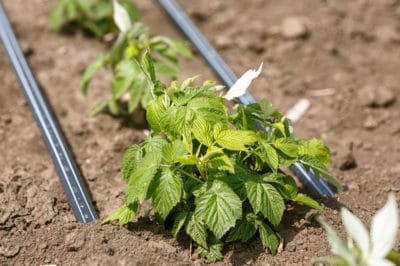Choose the Planting Site
Bountiful crops of raspberries begin with choosing the proper growing site. Choose a location that receives four to five hours of sunlight per day. Do not plant raspberries in soil that grew any cane berries, potatoes, tomatoes, peppers, or eggplant in the previous three years.
Prepare the Soil
Planting should not occur until organic matter such as peat moss, manure, plant-based compost, or cover crop is allowed to break down in the soil for a year. Testing the soil’s pH and nutrient content is advised so that amendments can be added if needed.
Choose the Cultivar
There are dozens of raspberry cultivars to choose from, but not all are suited for all climates. Finding the best cultivar for your location can be done by checking with your local county extension office or local university publications. These sources suggest a more exact timing of planting. Nursery catalogs also state what cultivars are best for your USDA Zone.
Raspberries grow best in USDA Zones 4-7. Growing them in more extreme climates is a challenge, but can be done if the right cultivar is planted at the proper time. Here are some cultivars and their recommended USDA Zones:
- Boyne (USDA Zones 3-7)
- Prelude (USDA Zones 4-8)
- Killarney (USDA Zones 4-7)
- Bristol (USDA Zones 5-8)
- Latham (USDA Zones 3-8)
- Polka (USDA Zones 4-8)
- Polana (USDA Zones 3-8)
- Baba Red (USDA Zones 4-11)
- Fall Gold (USDA Zones 4-11)
- Heritage (USDA Zones 4-11)
When to Plant
In cold climates, raspberries should be planted in the spring after the one-year soil preparation. Fall planting is best in some areas in the South. The timing will vary depending on the USDA Zone. The type of stock will also determine the timing of planting.
Bare-Root Cane Stock
Dormant bare-root canes should be planted as soon as the soil can be worked in the spring, but after temperatures consistently rise above 20°F (-7°C). If the bare-roots are potted, plant them only after the danger of frost is gone. Check the USDA Zone maps for the average last frost in your area.
Tissue-Cultured Stock
Some nurseries propagate raspberry stock from a small piece of the desired cultivar. Grown in a sterile environment, tissue-cultured plantings usually live longer, bear more fruit, and bear fruit earlier in the season. This stock is more tender than bare-root canes; therefore, planting should be delayed until all danger of frost is gone.
